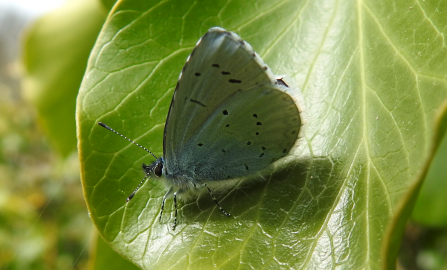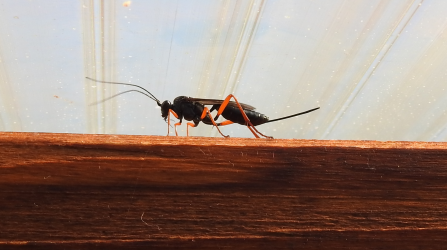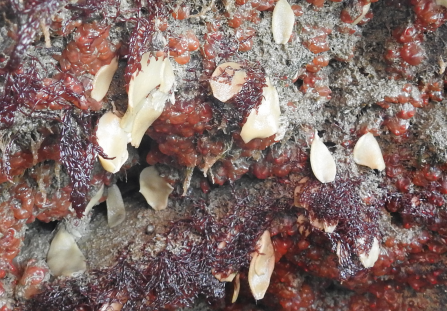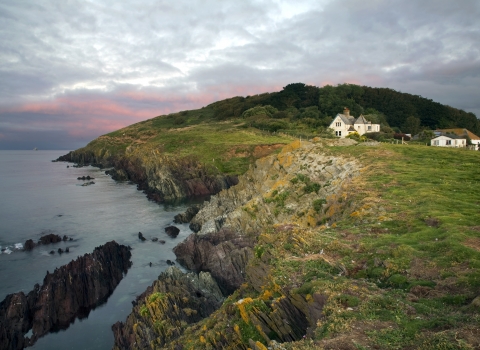The Boomerang has come back! It left late last summer but it has returned.
OK, not a real Boomerang but an impressive male seal, named after the shape of a scar on his back. Every year he returns in April – welcome back big boy.
Sunlight through the woods - Claire Lewis
The Boomerang has come back! It left late last summer but it has returned.
OK, not a real Boomerang but an impressive male seal, named after the shape of a scar on his back. Every year he returns in April – welcome back big boy.
Boomerang the seal - Sue Sayer of Cornwall Seal Group Research Trust
Recently we’ve been seeing lots of Holly Blue butterflies. They are small and sweet but if you look at their underwings, not necessarily blue. In fact they are silvery with black spots. Oh and their legs and antennae are a really funky with black and white stripes! In the Spring you often find them around Holly but later in the year you are more likely to spot one by Ivy. Now, I’m sure there’s a song about that...

Holly Blue - Claire Lewis
Each year the numbers of this little blue butterflies really varies. Its all to do with a parasite that shares its life cycle with the butterfly. Which leads me nicely on to…
Parasitoid wasps. There are over 6,000 types of these insects in the UK. I am fascinated by them, so I just had to share this photo of one I spotted in our kitchen. I’ll see if those good people at ERCCIS can identify the species, but for now I’ll call it ‘hot legs’ (Edit: the Wildlife Information Service identified the species as Buathra laborator). As you’ll notice from the photo, this orange legged individual was only a couple of centimetres long but it looks a bit threatening, so close your eyes and skip the next bit if you’re easily scared…

Parasitoid wasp - Claire Lewis
That big ‘sting’ is impressive, isn’t it? Only it’s not a ‘sting’ but something the wasp uses to lay eggs…. inside other small creatures – urgh! The wasp starts out as a parasite and ends up as a predator. It seeks out ‘prey’ creatures into which it can its lay eggs. Frequently this might be inside of an egg, caterpillar or pupa of a butterfly, like a Holly Blue - oh no! Like a normal parasite, the wasp’s eggs grow inside its living host. Keeping the host alive means a fresh supply of food – yum. But at some point the developing wasp needs to ‘hatch out’ – inevitably killing its host in the process. It then becomes a predator as it just killed its prey. I did warn you - gruesome!
I have a soft spot for Green alkanet.
It is in fact ‘an alien’ as until a couple of hundred years ago, it wasn’t found in Britain. Somehow it spread here and now the botanists describe it as ‘naturalised’. So, why do I like it? It’s because Green Alkanet grew everywhere in the gardens of a quirky flat I used to rent near Falmouth. A flat surrounded by Monkey Puzzle trees and bats, but that’s a whole different story…
Green alkanet - Claire Lewis
Anyway I know that name is misleading, as the flowers are an intense bright blue, not green, and their issue with colour doesn’t stop there. The young flower buds are a pretty pink and the plant’s roots can produce dyes - ones which are reddy-purpley-burgundy colour. Maybe it should be called rainbow alkanet? Still the bees love it. Apparently bees ‘see’ colour differently to us and are particularly partial to shades of blue.
Hawthorn blossom - Claire Lewis
As May is approaching I’ve been looking out for hawthorn blossom. When I found some I took a close look at the pretty flowers and noticed that it has pink anthers. What? Anthers and stamens, not terms you use every day but I remember learning about them at school. Anthers are the tiny bundles of pollen at the end of stamens. They can be different colours but I’ve never noticed this dusky pink before.
Hawthorns are one of those plants that are often listed as being great to plant for wildlife. In particular it is happily munched by caterpillars of many moths, including, unsurprisingly the hawthorn moth, but also moths with great names like orchard ermine, lackey, and vapourer. On the island its flowers provide insects with nectar and pollen, its haws (or fruits) are eaten by many birds and the dense, thorny foliage makes fantastic nesting shelter for many species of bird from thrushes to chaffinches. Overall, let’s face it, it’s a top plant.
Shags are funny.
It’s not just their name, it’s how they look. At this time of year they have a pronounced tuft of quiff-like of feathers on their head. In fact, their name is said to come from an old word meaning tuft or crest.
Shag shadow - Claire Lewis
It’s all about looking good to attract a mate but honestly, I wouldn’t be able to take this character seriously, would you? Still they do breed successfully here. Like the cormorants their nests are on the cliffs but whereas the ‘cormies’ nests are generally on the ledges, the shags nests tend to be more tucked away in crevices. Fascinating fact time: from the surface, Shags can dive down to depths of up to 45m to catch fish – now that is an impressive ‘duck dive’!
Fulmar - Claire Lewis
After a winter spell away at sea the Fulmars have return to the island. They are one of my favourite seabirds. They have cute ‘dumpy’ white bodies but it’s their bill and eyes that impress me most. The thick bill is topped with a ‘tubenose’ – this means they can drink sea water and use the tube to expel the salts. And the eyes? I just think they look like they took a lesson from Cleopatra with smoky black kohl eyeliner!
Fulmars are long lived birds – up to 44 years. Generally they don’t start thinking about breeding until they are around 6 years old but then they mate for life. With their partner they start prospecting for a nest site, and boy are they choosy. The pair will trial a potential location for a couple of years (!) before deciding that it’ll make a good place to start a family. Each time they meet up at the site they’ll romantically strengthen their bond by rubbing their bills together and making wonderful cackling sounds. Then when they are around 9 years old and happy with their chosen site they’ll lay and incubate just one egg. Between them they’ll incubate that precious egg for just over 50 days and then it’ll be a little under 50 days or so before the young grey fluff ball of a chick, blossoms into a beautiful adult fulmar and fledges. Once it can fly it’ll stay at sea for… four (!) years before coming back to land - incredible.
Fulmars at nest site - Claire Lewis
Now, I probably haven’t mentioned this yet, but one of the reasons that the island is so special is because of its coastline. In fact it’s Cornwall Wildlife Trust only specific Marine Nature Reserve – check us out! For me the most exciting part is the rocky shore. The sheltered side of the island has lots of nooks and crannies where all kinds of marine life can be found. In places it can be incredibly diverse and colourful.
Rainbow under the seaweed - Claire Lewis
Underneath the seaweed this rock face was covered in all sorts of life such as purple encrusting algae and orange sponges and young limpets. But it was the little cream flattened pockets hanging from the surface that caught my eye. I knew I’d seen them here before but I’d forgotten what they were called. Luckily the excellent local guru of all things rock pool, Heather Buttivant came to the rescue. It was Purse Sponges that I’d seen. Brilliant.
Although they look like plants, sponges are amongst the earth’s oldest (and simplest) animals. Apparently they have water flowing through their body up to 20,000 times their own volume each day! In the water they find everything they need to survive - plankton, bacteria and oxygen. Ahh, the simple life.

Cluster of Purse Sponges - Claire Lewis
Did you know that Grey Seals can sleep in the sea as well as on land? Nope? Well, they can and they do.
Mostly we see them bobbing in the water like a bottle with just their heads at the surface. Can you guess what this behaviour is called? It’s called ‘bottling’ of course! Usually you see them bottling in their own little patch of water but the other day I spotted a seal (possibly a new young male) fast asleep by Duchess. Duchess is a super chilled out mature seal. She knows how to stay put while sleeping in the water. It wasn’t the same for the younger seal though – it kept drifting around until it freaked itself out by almost bumping into Duchess. Oh and it also had that unfortunate habit of dropping its mouth open and dribbling while asleep...
It has to be...
Sunset view from Looe Island - Claire Lewis

David Chapman
Grey Seal halued out